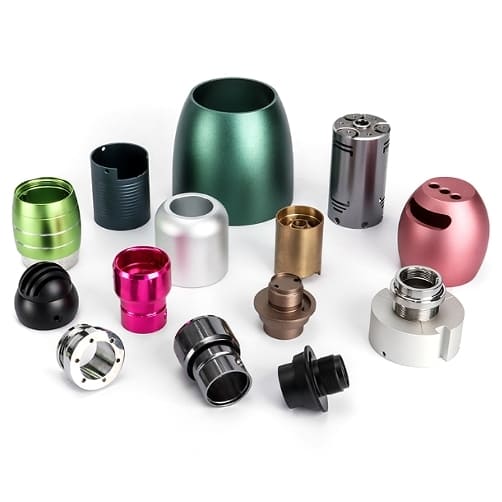PEEK (Polyetheretherketone) is a high-performance thermoplastic that offers outstanding durability and heat resistance. However, machining this material isn’t as straightforward as working with others. The toughness of PEEK demands specific techniques and tools, which can be challenging to master. In this article, I’ll break down the key elements of PEEK machining and offer insights into how to effectively work with this advanced material.
PEEK machining involves creating custom parts from PEEK material through processes like CNC machining, turning, and milling. It requires specialized tools and expertise to achieve the precision and quality that make PEEK so valuable.
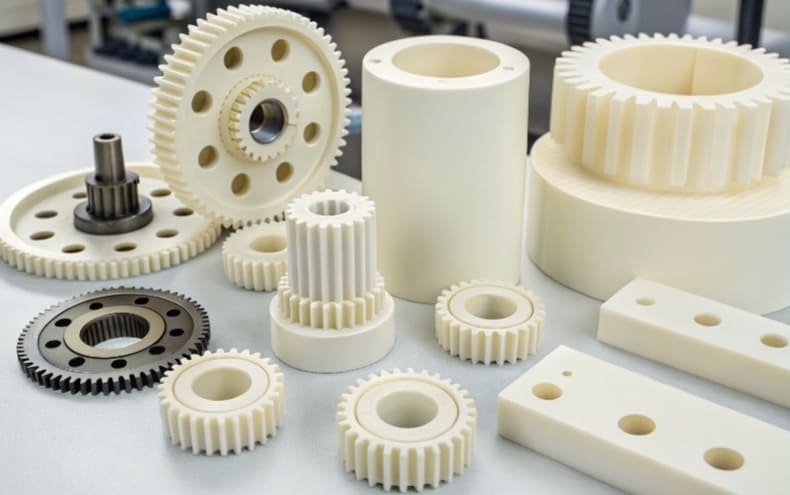
Now that we’ve introduced PEEK, let’s explore its unique properties that make it ideal for specific high-performance applications.
What is the property of PEEK material?
PEEK stands out for its exceptional performance in extreme conditions. From high temperatures to chemical resistance, this material has unique properties that make it a top choice for industries like aerospace and medical. But what exactly makes it so valuable?
PEEK is known for its excellent chemical resistance, high-temperature stability, and mechanical strength. It can withstand harsh environments and still maintain its structural integrity.
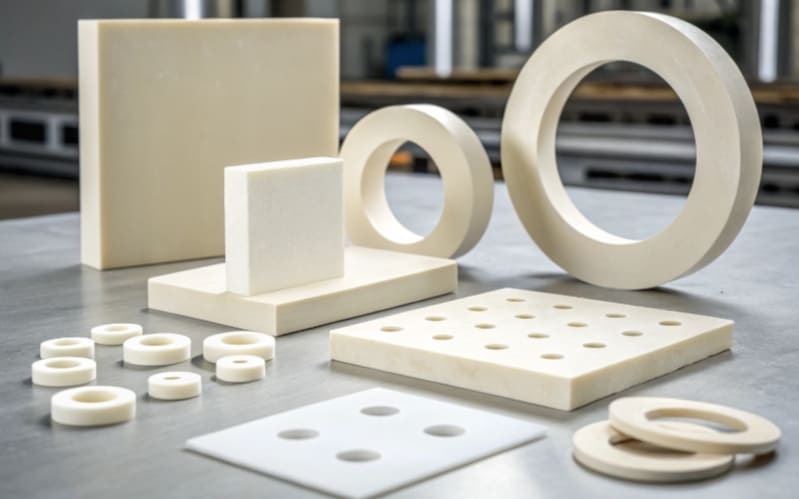
High-Temperature Stability
PEEK maintains its mechanical properties at temperatures up to 260°C (500°F), making it suitable for environments where other materials would soften, degrade, or fail. This characteristic makes it particularly valuable in aerospace, automotive, and industrial applications where heat resistance is paramount.
Chemical Resistance
PEEK is highly resistant to a wide range of chemicals, including acids, bases, and solvents, making it ideal for use in chemical processing and medical applications. This resistance extends the life of components exposed to harsh chemicals, reducing maintenance costs and ensuring long-term reliability.
Mechanical Strength and Durability
PEEK has excellent Tensile strength1, making it capable of withstanding mechanical stress. Its resilience to wear, impact, and fatigue allows it to be used in high-load applications like bearings, seals, and gears.
PEEK excels in situations where other materials fail. Its ability to endure high temperatures, resist aggressive chemicals, and remain strong under mechanical stress makes it indispensable in many advanced manufacturing applications. Understanding these properties is key to determining when PEEK is the right material for your parts.
What is the Application of PEEK machining parts?
PEEK’s versatile properties make it ideal for a variety of high-demand applications. But how is it actually used in the real world? Let’s explore some of the most common uses for PEEK parts.
PEEK is used in industries such as aerospace, automotive, medical, and oil & gas, where parts must endure extreme conditions without failure. It’s commonly machined into seals, bearings, insulators, and components for engines or implants.

Aerospace
In aerospace, PEEK is used for manufacturing turbine blades, seals, insulators, and other critical components. The material’s high-temperature stability and strength make it essential for parts exposed to extreme heat and stress, such as those found in jet engines or fuel systems.
Medical
In the medical field, PEEK is commonly used for implants such as spinal fusion devices, orthopedic joints, and dental implants. Its Biocompatibility2, strength, and wear resistance make it an ideal material for these applications, as it can safely withstand the stresses placed on the human body without degradation.
Automotive
PEEK’s high-performance characteristics are used in automotive components like fuel system parts, high-temperature seals, bearings, and engine components. The material’s resistance to heat and wear ensures the longevity and efficiency of these critical parts.
PEEK is found in critical applications, such as turbine blades in aerospace and medical implants. These applications require materials that perform under extreme stress and temperatures. Machining PEEK for these purposes requires a deep understanding of its behavior and the specific challenges each industry presents.
What is the advantage and disadvantage of PEEK material?
PEEK is highly praised for its performance, but no material is without its drawbacks. Let’s take a closer look at the benefits and limitations of using PEEK in machining.
The advantages of PEEK include high strength, excellent wear resistance, and the ability to function in extreme temperatures. However, its high cost and difficulty in machining can be a significant downside.
Advantages:
- Outstanding Durability: PEEK has a long service life even in high-stress, high-temperature environments. It resists wear, tear, and fatigue, making it ideal for parts that require long-term performance.
- Excellent Chemical Resistance: PEEK is resistant to a wide range of chemicals, which is critical for industries like pharmaceuticals, food processing, and chemical manufacturing.
- High-Temperature Performance: It can perform at temperatures up to 260°C without degrading, allowing it to be used in high-heat applications like turbine engines and industrial machinery.
Disadvantages:
- High Cost: PEEK is more expensive than many other plastics, which can make it cost-prohibitive for applications where other materials could suffice.
- Machining Difficulty: Its toughness and high melting point make machining PEEK more challenging than other materials, requiring specialized equipment and techniques.
While PEEK excels in challenging environments, it comes with its own set of hurdles. Its high cost and the complexity of machining can be prohibitive for some applications. Knowing when to use PEEK and when to opt for a different material can save both time and money.
What is the machining process of PEEK step by step?
Machining PEEK is not as simple as it might seem. Achieving the desired precision requires careful attention to each step of the process. Below is a detailed breakdown of the machining steps, with specific instructions on how to process PEEK parts efficiently.
PEEK machining typically involves turning, milling, and drilling operations, all of which need to be conducted under precise conditions to prevent material deformation and ensure quality. Each machining step must be optimized to avoid thermal damage, ensure dimensional accuracy, and prevent surface defects.
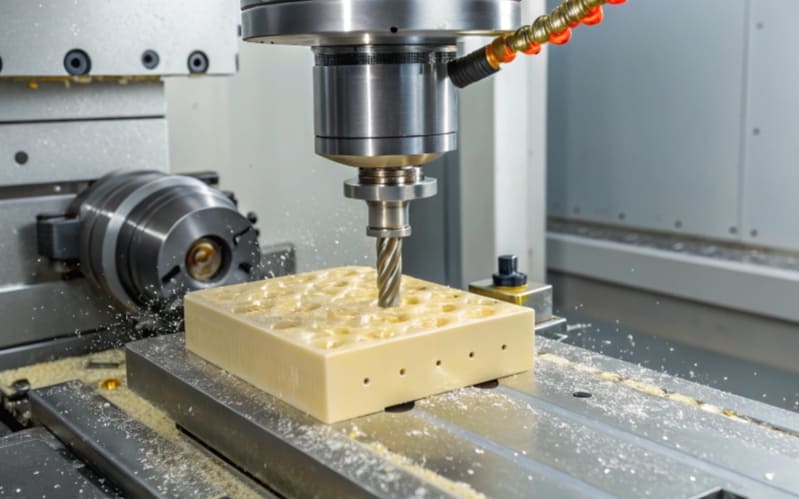
1. Preparation Phase
- Material Inspection: Before starting, inspect the PEEK material for any visible defects. Ensure the material is free of cracks or contamination, which can affect machining quality.
- Tool Selection: Choose the appropriate cutting tools based on the machining operation. For general machining, carbide tools are preferred due to their wear resistance and high-speed cutting ability.
- Cutting Fluid: Prepare a suitable cutting fluid to help dissipate heat, reduce friction, and improve surface finish. Water-soluble cutting fluids or synthetic coolants are typically used.
- Machine Setup: Secure the PEEK material onto the CNC machine or lathe. Double-check that the workpiece is aligned and fixed properly to avoid shifting during the cutting process.
2. Turning Operation
Turning is typically used to machine cylindrical PEEK parts or for making certain external features.
- Tool Choice: Use carbide insert tools for turning, as they are durable and able to handle the heat generated during cutting.
- Speed and Feed Rate: Set the lathe to a low-to-medium cutting speed (e.g., 200-300 m/min) to prevent excessive heat buildup. The feed rate should be moderate (e.g., 0.1-0.3 mm/rev) to ensure smooth cutting and reduce stress on the tool.
- Cut Depth: Start with a shallow cut depth (0.5-2 mm) to avoid overheating. Avoid deep cuts in a single pass, as this could lead to excessive heat and potential material deformation.
- Coolant Application: Apply coolant during the operation to keep the temperature under control. Ensure the coolant is directed at the cutting tool and workpiece to prevent localized overheating.
- Tool Path: When turning, use a continuous feed and avoid intermittent cuts to reduce the risk of tool wear and vibrations that could affect the precision of the part.
3. Milling Operation
Milling is used for creating flat surfaces, slots, pockets, or complex geometries.
- Tool Choice: Use end mills or face mills with carbide coatings for milling. For rough milling, select a tool with a larger cutting radius to improve stability.
- Cutting Parameters:
- Speed: Set the spindle speed between 2000-3000 RPM, depending on the tool size.
- Feed Rate: The feed rate should be moderate, around 500-1500 mm/min for general milling operations.
- Depth of Cut: For rough cuts, set a depth of cut between 2-4 mm. For finishing cuts, reduce the depth to 1-2 mm for higher precision and better surface quality.
- Cooling: Ensure continuous coolant flow to keep the material cool, especially during deeper cuts. Cooling is crucial to prevent melting or warping of the material.
- Tool Movement: Maintain a consistent cutting action. In some cases, slow down the feed rate when finishing to ensure a smooth surface finish.
- Avoid Vibration: PEEK can experience vibrations during milling if the machine setup or cutting parameters aren’t properly tuned. Use a light cut and low feed rates to minimize Tool deflection3 and vibration.
4. Drilling Operation
Drilling is used to create holes in PEEK parts. The key is to ensure that the cutting process does not overheat or warp the material.
- Tool Selection: Use high-speed steel (HSS) drill bits or carbide drills. Ensure the drill has a sharp cutting edge and is suitable for the material’s hardness.
- Drilling Speed: Set the drill speed between 800-1200 RPM for smaller diameter holes, and adjust it proportionally based on the size of the hole.
- Feed Rate: Use a low feed rate (e.g., 0.1-0.3 mm/rev) to ensure steady cutting and prevent excessive pressure on the drill bit.
- Chip Removal: The chips generated during drilling must be effectively removed to prevent clogging. Use peck drilling (a process where the drill bit is gradually advanced in stages) to help remove chips and reduce heat buildup.
- Coolant Application: Apply a consistent flow of coolant to reduce friction, prevent overheating, and maintain the quality of the hole.
5. Finishing Operations (Polishing and Surface Treatment)
After the main machining operations, it’s important to focus on the surface quality, especially for parts that will be exposed to friction or need a smooth finish for aesthetic purposes.
- Polishing: Use a fine-grit abrasive or polishing compound to remove machining marks and enhance surface smoothness. PEEK parts can be polished using diamond polishing tools or abrasive belts.
- Deburring: After cutting, use a deburring tool or abrasive pad to remove sharp edges from the part. This is important to avoid stress concentrations and ensure safety, particularly for medical or aerospace parts.
- Surface Treatment: In some cases, PEEK parts may undergo surface treatments such as Flame polishing4, which enhances the finish and smoothness of the part by melting the surface layer.
6. Quality Control and Inspection
After machining is complete, inspect the part to ensure it meets the required specifications.
- Dimensional Inspection: Use a micrometer or coordinate measuring machine (CMM) to check the part’s dimensions. Ensure that tolerances are within acceptable limits.
- Visual Inspection: Check for any surface defects, cracks, or discoloration. The surface should be free from gouges or irregularities.
- Functional Testing: For parts that will undergo specific functional tests (e.g., pressure testing for seals or wear testing for bearings), perform these tests before final acceptance.
Common Challenges and Solutions:
- Thermal Deformation: PEEK is sensitive to temperature changes during machining. Excessive heat can lead to material warping or softening. To combat this, use lower cutting speeds, moderate feed rates, and ensure proper cooling throughout the process.
- Tool Wear: Because of PEEK’s toughness, tools can wear out more quickly compared to machining softer materials. Regular tool inspections and replacing worn tools can help maintain precision and reduce downtime.
- Chip Removal: PEEK produces small chips that can clog cutting zones, leading to overheating or surface defects. Effective chip removal strategies, such as using high-pressure coolant or adjusting feed rates, help minimize this issue.
By following these detailed steps and paying attention to the specific challenges involved, you can successfully machine PEEK parts with high precision and quality, meeting the demands of industries like aerospace, automotive, and medical.
What are the common techniques used in PEEK machining?
When machining PEEK, different techniques can be employed depending on the part’s complexity and the precision required. Let’s take a closer look at the most common methods.
CNC machining, laser cutting, and water jet cutting are the most common techniques used to machine PEEK, each offering distinct advantages depending on the part complexity and thickness.
Techniques Breakdown:
- CNC machining: Ideal for precise, repeatable cuts with high-quality surface finishes. It allows for tight tolerances and complex geometries to be achieved.
- Laser cutting: Great for cutting thinner materials or creating quick prototypes. It offers high precision but may not be suitable for thicker sections of PEEK.
- Water jet cutting: Perfect for thicker sections and intricate designs with minimal heat influence. This technique uses a high-pressure stream of water mixed with abrasives to cut through the material without causing thermal damage.
Choosing the right technique depends on the part’s design and the specific requirements for accuracy and speed. CNC machining is great for high precision, while laser cutting and water jet cutting are suitable for different applications based on material thickness and complexity.
What cutting tools are used for PEEK machining?
The right cutting tools can make or break a machining process, especially when working with a tough material like PEEK. Let’s explore the best tools for machining PEEK effectively.
Carbide tools, polycrystalline diamond (PCD) tools, and high-speed steel (HSS) tools are commonly used for PEEK machining, each offering specific advantages in terms of wear resistance and precision.
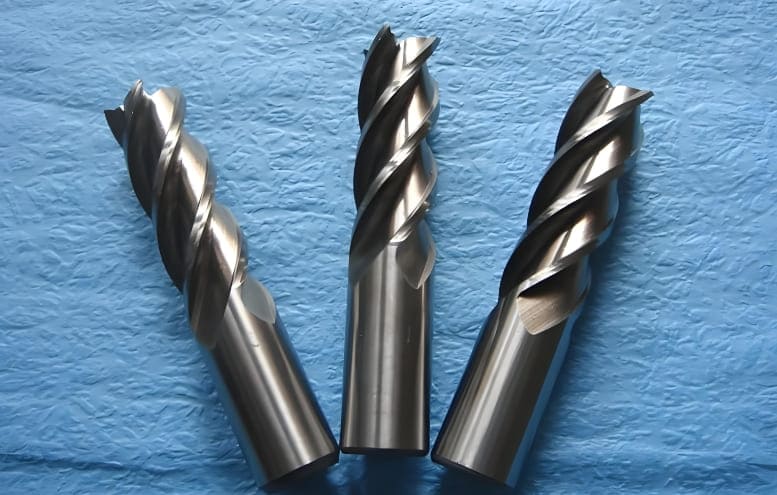
Tool Selection for PEEK:
- Carbide Tools: Best for high-speed cutting and general machining needs. Carbide offers excellent wear resistance and can withstand the high temperatures generated during cutting.
- PCD Tools: Ideal for intricate parts requiring superior precision. PCD tools are known for their ultra-fine finish and high hardness, making them suitable for tight tolerances.
- HSS Tools: Cost-effective and suitable for standard machining applications. While HSS tools wear more quickly than carbide, they are still widely used for lower-volume machining tasks.
Selecting the correct tool is crucial to achieving the desired results. The wrong tool choice can lead to excessive tool wear, poor surface finish, or part deformation.
How to choose the right machining process for your PEEK parts?
Choosing the right machining process is crucial when working with PEEK. It can affect both the quality of the final product and your production efficiency. Here’s what you need to know.
The right machining process depends on part geometry, production volume, and precision requirements. Balancing these factors helps streamline your process and reduce costs.
For complex parts requiring tight tolerances, CNC machining is often the best method. However, for high-volume production or simpler designs, injection molding or other automated processes may be more efficient. Understanding the needs of your project will help you make an informed decision on which machining process to choose.
How is PEEK machined to achieve precision?
Precision is essential in PEEK machining, but how do you ensure that every part meets exact specifications? Let’s explore the key techniques used to achieve high precision in PEEK machining.
Achieving precision in PEEK machining requires controlling cutting speeds, feed rates, and cooling systems to prevent material deformation and thermal damage.
Key Techniques for Precision:
- Constant Temperature Control: Maintaining a stable temperature during machining prevents the material from softening or deforming. This can be achieved using coolant systems or controlling machine settings.
- Feed Rate Optimization: Carefully controlling the feed rate ensures that the material is cut smoothly without causing excess friction or heat buildup.
- Tool Wear Monitoring: Regular monitoring and maintenance of tools help maintain consistent precision, especially when working with a tough material like PEEK.
Precision in machining PEEK isn’t just about the equipment; it’s also about the conditions under which the machining takes place. Temperature management, consistent feed rates, and proper tool maintenance are all necessary for high-precision parts that meet stringent requirements.
How PEEK benefits aerospace and automotive industries?
PEEK’s unique properties make it an ideal material for the aerospace and automotive industries. Let’s dive into how PEEK is helping these sectors thrive.
PEEK’s high strength, durability, and resistance to extreme conditions make it a game-changer in the aerospace and automotive industries, where performance under pressure is critical.
Aerospace Applications:
PEEK is used in critical aerospace components such as turbine blades, seals, and electrical insulators. The material’s ability to endure high temperatures and mechanical stress makes it essential in both civilian and military aircraft.
Automotive Applications:
In the automotive sector, PEEK is employed in fuel systems, bearings, and seals. Its high-temperature resistance ensures that parts maintain performance even under the heat generated in engines or exhaust systems.
PEEK is commonly used in aerospace for turbine blades, seals, and electrical insulators. In automotive, it serves as an excellent material for bearings, seals, and high-performance components that need to withstand extreme temperatures and wear. Its ability to handle such stress makes it indispensable in these industries.
Why is PEEK so expensive?
PEEK is widely recognized as an expensive material, but what drives its cost? Is it justified, and is it worth the investment?
The high cost of PEEK comes from its complex manufacturing process, the specialized equipment required for machining, and the material’s limited availability.
PEEK’s high price tag is a result of its intricate production process and the need for specialized tools and machinery. The scarcity of high-performance materials like PEEK also plays a role in driving up its cost. For industries that require the best performance in extreme environments, however, the investment is often well worth it.
Is PEEK easy to machine?
Many people assume that machining PEEK is straightforward due to its versatility. But is it really that easy? Let’s explore the challenges involved.
PEEK is not the easiest material to machine due to its toughness and heat resistance. Special attention to temperature control and cutting parameters is necessary to avoid defects.
Machining PEEK can be challenging due to its durability and tendency to soften under high heat. Without proper control over temperature and cutting speeds, the material can become difficult to work with, potentially leading to defects in the final product.
Is PEEK harder than steel?
PEEK is a strong material, but how does it compare to steel when it comes to hardness? Let’s take a closer look.
PEEK is not harder than steel in terms of raw hardness, but it offers superior resistance to heat and wear, which makes it more suitable for high-performance applications.
Steel may be harder than PEEK in terms of tensile strength, but PEEK’s exceptional resistance to heat, chemicals, and wear makes it the material of choice in extreme environments. In applications where heat resistance is crucial, PEEK outperforms steel in terms of long-term durability.
Is PEEK stronger than Delrin?
When comparing PEEK to Delrin, many wonder which material offers superior strength in various applications. Let’s explore the differences.
PEEK is stronger than Delrin in high-temperature environments and can withstand greater mechanical stresses, making it more suitable for demanding applications.
While Delrin is a strong material, PEEK excels in higher-temperature environments and offers better mechanical properties. This makes PEEK a more reliable choice for parts exposed to extreme conditions.
Is PEEK as strong as aluminum?
Aluminum is widely regarded as a strong material, but how does PEEK compare? Let’s find out which material is better suited for different applications.
PEEK is not as strong as aluminum in terms of tensile strength, but its performance in high-heat and chemically demanding environments gives it an edge over aluminum in certain applications.
Aluminum may outperform PEEK in tensile strength, but PEEK is superior when it comes to handling extreme temperatures, chemicals, and wear. In industries that face harsh conditions, PEEK is often the material of choice.
Conclusion
PEEK machining is complex, but understanding its properties, applications, and challenges can help you make informed decisions for your parts. Whether you’re in aerospace, automotive, or medical fields, PEEK offers significant benefits for the right projects.
-
Understanding tensile strength is essential for evaluating materials’ resistance to pulling forces, particularly for parts that will endure mechanical stress in demanding environments. ↩
-
Biocompatibility is key in medical applications, ensuring materials are non-toxic and safe for prolonged use in the human body, especially for implants and prosthetics. ↩
-
Tool deflection affects machining precision, making it critical to manage cutting conditions to prevent dimensional inaccuracies and surface defects. ↩
-
Flame polishing is a technique that uses controlled heat to smooth polymer surfaces, reducing roughness and improving the visual and physical properties of parts. ↩
